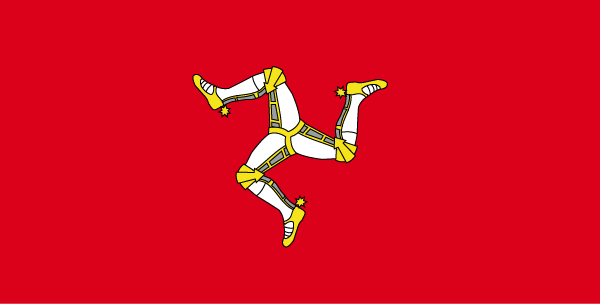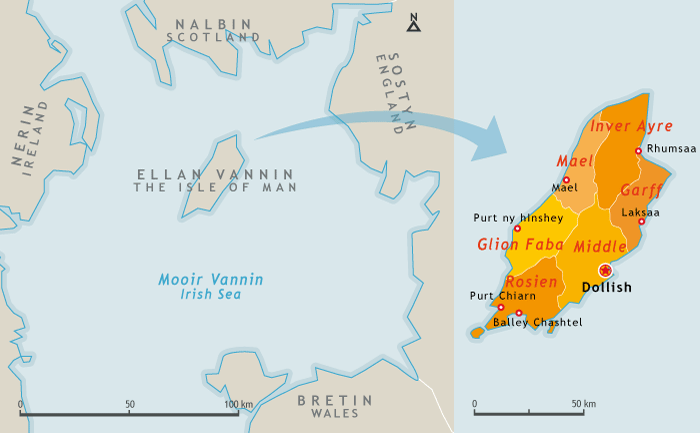The Isle of Man, at the inter Celtic crossroads

The Isle of Man is the smallest Celtic nation. Situated at equal distance between Scotland, Ireland, England and Wales, it has much autonomy but is not known as a sovereign state.

Dependent on the British crown, the Isle of Man is not part of the United Kingdom. Thus, even if the island is not independent and Queen Elizabeth II is the recognised sovereign there, it benefits de facto from a quasi-state status. Some abilities remain the prerogative of the United Kingdom, such as foreign affairs and defence. The parliament of the island is considered one of the oldest in the world and dates back to 979. It is known as the Tinvaal (Tynwald in English). It is made up of two rooms: the Kiare as Feed (Room of Keys), elected by direct suffrage, and the Yn Choonseil Slattyssaghle, legislative council, elected by indirect suffrage. Equally, it is one of the first European countries to have granted voting rights to women (1866).
Marked by Scandinavian influence, the Isle of Man nevertheless retains a strong Celtic culture. The last native speaker of Manx, Ned Maddrell, died in 1974. However, it is spoken as a second language by many thousands of Manx people. In spite of an important number of Britons installing a strong Anglicism, the Manx embarked on a campaign to reclaim their culture, notably music and dance, taught as extracurricular activities in schools.
As with the Faroe Islands, the Isle of Man benefits from a special regime which allows them to not be part of the European Union. The Manx pound is the money in circulation and the vigorous tax regime allows businesses to benefit from substantial advantages. Because of this it has become a true tax haven.

Identity card

| Name | Ellan Vannin | Manx Isle of Man | English |
| Population | 80,058 inhab. |
| Area | 572 km² |
| Languages | Gaelg | Manx English | English (official) |
| Number of native speakers | 1,689 | Manx (2001) |
| State of guardianship | United Kingdom |
| Official status | Dependency of the British crown |
| Capital | Doolish | Manx Douglas | English |
| Historic religion | Christian Anglican |
| Flag | Tree cassyn | Manx (The three legs) |
| Anthem | Arrane Ashoonagh dy Vannin | Manx (O Land of My Birth) |
| Motto | Quocunque Jeceris Stabit | Latin Aghterbee ceauee shiu eh, shassee eh | Manx (Whithersoever you throw it, it will stand) |

Timeline

- 500 BC • First Celts arrive on the island.
- 5th century • St Patrick, the Irish monk, brings Christianity to the Isle of Man.
- 9th–13th century • Scandinavian invasions and rule of the Norwegian kings, in particular Harald I, Magnus III and Håkon IV.
- 1275 • Battle of Ronaldsway; the Scottish drive away the Norwegian rulers.
- 1290 • England takes possession of the Isle of Man.
- 14th–18th century • The counts of Derby govern the island.
- 1866 • Creation of a local government. Beginning of Manx autonomy.
- 1960s • The Isle of Man becomes a tax haven in order to offset the economic crisis experienced by the island.
- 1974 • Death of Ned Maddrell, last native Manx speaker.
- 1990s • Opening of the first school in Manx.

Brief history

For a long time, the Scandinavians, most notably the Norwegians, reigned on the Isle of Man. In 1275, wishing to reinforce the authority of the Sudreyar, the island’s royal family of Norwegian origin, the Manx opposed the Scottish army, who were attempting to take control. During the Battle of Ronaldsway, the two groups clashed. The Scots won, which led to the death of King Godfred Magnusson and the flight of his court to Norway. Due to this defeat, the Manx people were later integrated into the British crown. Relations between the two Celtic people, Manx and Scottish, remain marked by this event, even though today, inter-celtism enables partial reconciliation between the old enemies and the discovery of a common centre of interest for the rebirth and unity of Celtic culture in Europe.

Geography

In the middle of the Irish Sea, the Isle of Man is made up of an island of more than 500 km² and three small islands (Caif, St Michael and St Patrick). Situated a little more than 50 km from Ireland, Scotland and England, it benefits from an oceanic climate which allows varied vegetation to be grown there: forests and pastures are interspersed. Its highest point, Sniall in Manx, Snaefell in English, reaches 621m. The island is divided into six sheadings, traditional administrative divisions: Glion Faba, Mael, Inver Ayre, Garff, Middle (the capital Douglas is found there) and Rosien.



